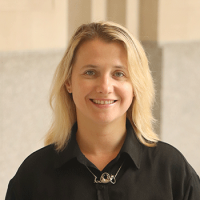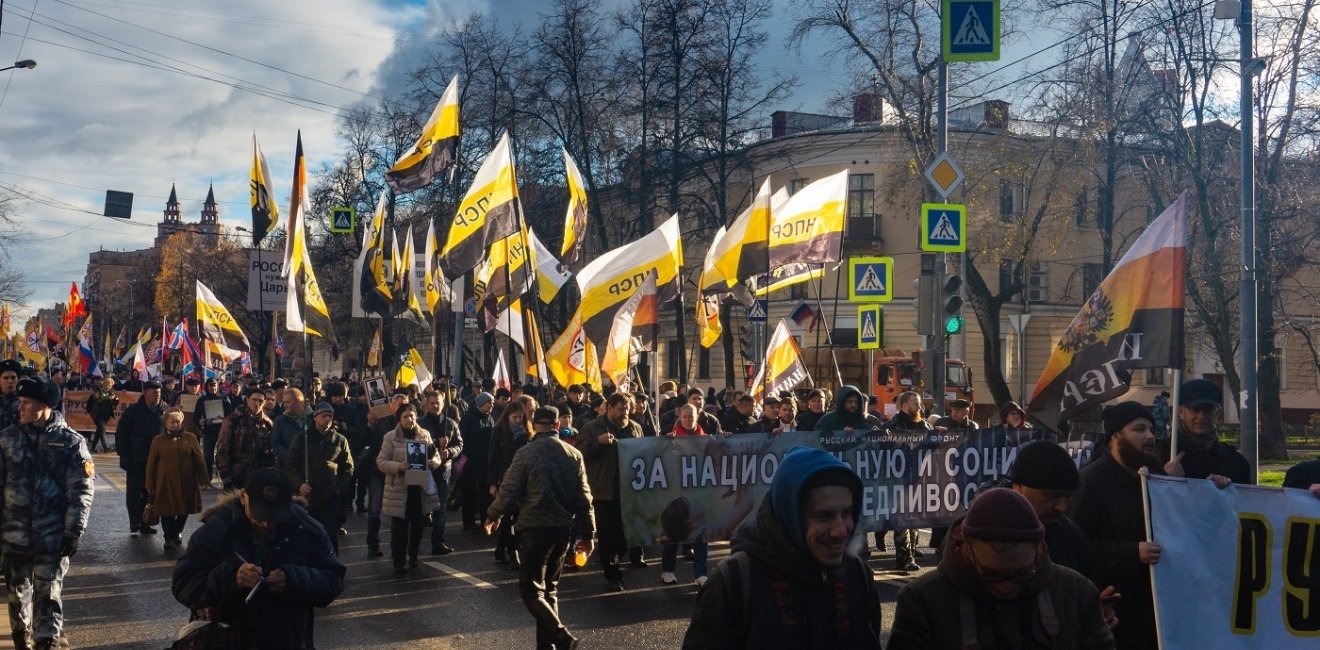
A blog of the Kennan Institute
In 2023, in addition to waging a brutal war against Ukraine, the Russian government continued to deploy so-called “traditional values” against the rights of women and LGBTQ+ citizens. Vladimir Putin also resumed his end-of-the-year press conference and the televised Direct Line call-in show, both of which he had skipped in 2022. With his orchestrated reelection looming in March, Putin held a four-hour marathon event combining the conference and the Direct Line on December 14.
Our recent research has shown the importance of unpacking gender and LGBTQ+ issues in the Russian political context. Below, we analyze the Russian ideology of “traditional values” in the service of the war and look at what Putin said and did not say at the press conference/Direct Line to understand the implications of his statements on women’s rights and his silences on LGBTQ+ people’s rights in Russia.
Tool of Repression Turned into War Fuel
Since Vladimir Putin’s return to the presidency in 2012, the notion of “traditional values” has been featured front and center in the regime’s crackdown on the opposition and civil dissent.
In the years leading up to the full-scale invasion of Ukraine, Putin’s rhetoric became increasingly homo-and transphobic, with repressive consequences. In 2021, Putin claimed that teaching children about gender fluidity was akin to a crime against humanity, and in 2022, he justified the full-scale invasion as resistance to the West’s attempts to “destroy [Russia’s] traditional values,” alleging that Russians who cared about “so-called gender freedoms” and opposed the war were, in essence, traitors.
Shortly after the widely unpopular “partial” military mobilization in the fall of 2022, Putin signed a decree that formalized the “protection of traditional values” as a state policy. Two weeks later, the Duma extended the “gay propaganda” ban to the entire public sphere, outlawing all forms of positive LGBTQ+ representation in the media, film, literature, and art. Viacheslav Volodin, the Duma chairman, celebrated the extended law as a triumph of Russia’s traditional values and as a way to protect Russian children from “the darkness spread by the United States and European countries.”
Not stopping at that, last summer the Duma passed a law banning gender transition and depriving all transgender and gender-nonconforming Russians of legal recognition and vital health care.
Then in November, at the request of the Ministry of Justice, the Russian Supreme Court ruled something they called the “international LGBT movement” to be an extremist organization. With no clarity on what they meant—there is no singular or identifiable “international LGBT movement” in Russia or globally—the designation will likely make it possible to prosecute all forms of LGBTQ+ advocacy in Russia and further threatens individual queer people. Indeed, in the aftermath of the court’s decision there was a flurry of police raids of gay clubs across Russia, while several LGBTQ+ advocacy groups shut down their operations, leaving the remaining activists to deal with a flood of requests from the LGBTQ+ community for help with emigration.
Surprisingly, Putin said nothing about this repression or LGBTQ+ issues at the 2023 press conference/Direct Line combo. His silence reflects the latest phase of Russian state-sponsored homo- and transphobia that builds on the long-standing Soviet legacy of homosexual erasureand criminalization. Throughout most of Soviet history, the penal code outlawed sexual relations between men, while female homosexuality was condemned as a mental illness. The very notion of nonheterosexual desire was erased from the public sphere, condemning LGBTQ+ individuals to a life of silence and hiding.
Russia decriminalized same-sex relations after the Soviet collapse, but homophobia remained widespread, making any progress in LGBTQ+ advocacy and acceptance of queer lives slow. The Kremlin eventually capitalized on this lack of progress when it introduced “gay propaganda” laws, which painted LGBTQ+ Russians as a threat to traditional values. The scapegoating effects of banning “gay propaganda” increased violence and discrimination against LGBTQ+ people, pushing many back into the closet or out of the country. With the Supreme Court’s labeling of LGBTQ+ activism as extremist coming into effect on January 10, more and more queer and trans Russians will likely turn to these survival tactics.
Mixed Rhetoric on Abortion
In contrast, Putin made several comments on women’s rights in response to a question about his position on banning abortion. Putin’s answer was the very definition of mixed messaging. He insisted that “women’s rights and freedoms must be observed.” But he also mentioned the state’s interest in population growth and thus its preference that pregnant women “decide to keep their baby,” proposing that a large part of the solution to increasing the number of births was to appeal to the Russian “traditional value” of having a large family. Finally, Putin spoke about the need to address practical matters that affect the birth rate, such as the level of support provided to families with children and the conditions of hospitals where women give birth.
Putin’s conflicting yet relatively measured language regarding abortion reflects another Soviet legacy. The Soviet model of women’s emancipation recognized women’s rights to education and paid work, while also ensuring abortion access. While post-Stalinist Soviet family planning was never explicitly feminist in its reasoning, abortion on demand was its cornerstone. Putin’s rhetorical dance between the polar opposites of women’s rights and traditional values also resembles the messiness of the Soviet approach to abortion, which, as Mie Nakachi writes, combined state pro-natalism with a recognition of women’s right to control their own fertility.
At the same time, several Russian regions have introduced bans on “encouraging” women to have abortions and have put pressure on private health clinics to stop providing pregnancy termination services. In addition, in October, the Ministry of Health announced plans to tighten the distribution of mifepristone and misoprostol, medications used in terminating early pregnancies. Currently the Duma is considering a federal ban on abortions in private clinics, which provide around 20 percent of these procedures.
The Future of Women’s and LGBTQ+ Rights in Russia
For the better part of Putin’s decades in power, mass audience events like the end-of-the-year press conference or the Direct Line have served as important forums in which the president both explains his regime to broad audiences and maintains the appearance of an ongoing “dialogue” between himself and ordinary Russians. Judging by Putin’s silences on LGBTQ+ issues and his statements regarding abortion, we suspect that the Kremlin will continue the wholesale erasure of queer citizens’ rights but may not be as straightforward regarding restrictions on women’s rights. But Russia’s LGBTQ+ and women citizens are resisting.
Pushing LGBTQ+ Russians out of the country may lead to further mobilization of Russian queer diasporas abroad, and to new forms of transnational political activism. Both processes have already been happening for at least a decade, since Russia first adopted homophobia as a state policy. At the same time, with international borders closing and growing economic instability at home, emigration would be difficult if not impossible for most LGBTQ+ Russians. One of the goals for the transnational and migrant activist community should be finding new, possibly covert ways to support those unable to leave.
On Russian women’s rights, one important space to watch is the mounting resistance movement by women relatives of mobilized soldiers. In recent months, they have been rallying to bring their husbands and sons back from the front lines. So far, despite the harsh criticisms of the mobilization, the war, and of Putin himself voiced on these women’s social media, the authorities have been reluctant to attack them openly as they have done to other antiwar activists, such as Russia’s Feminist Antiwar Resistance—perhaps precisely because as soldiers’ wives and mothers they remain legitimate in the eyes of society.
At the same time, with Putin increasingly siding with ultraconservatives since the beginning of the full-scale invasion, and with Russia continuing to experience a population decrease as a result of the loss of human life in the war and emigration, it seems likely that the pressure on women to have more children, with or without further restrictions on their reproductive rights, will only get stronger.
Meanwhile, as “traditional values” are used in Russia to justify the ongoing brutalization of Ukraine, millions of Ukrainian women are being affected by Russia’s war, including those whose reproductive rights were eradicated by sexualized violence, trauma to their health, displacement to Poland, where abortion is illegal, and damage to Ukraine’s health care infrastructure. Putin’s praise during the December press conference/Direct Line of his cousin, Anna Tsivilyova, the head of the Defenders of the Fatherland Foundation, suggests that the regime’s militarized traditional values paradigm will continue, perhaps even beyond the bounds of Putin’s presidential term.
The opinions expressed in this article are those solely of the author and do not reflect the views of the Kennan Institute.
Authors





Kennan Institute
The Kennan Institute is the premier US center for advanced research on Eurasia and the oldest and largest regional program at the Woodrow Wilson International Center for Scholars. The Kennan Institute is committed to improving American understanding of Russia, Ukraine, Central Asia, the South Caucasus, and the surrounding region through research and exchange. Read more

Explore More in The Russia File
Browse The Russia File
Chechnya as a Model of Modern Russia

Russia’s Indigenous Communities and the War in Ukraine

Gas and Power in a Changing US–Russia Relationship

